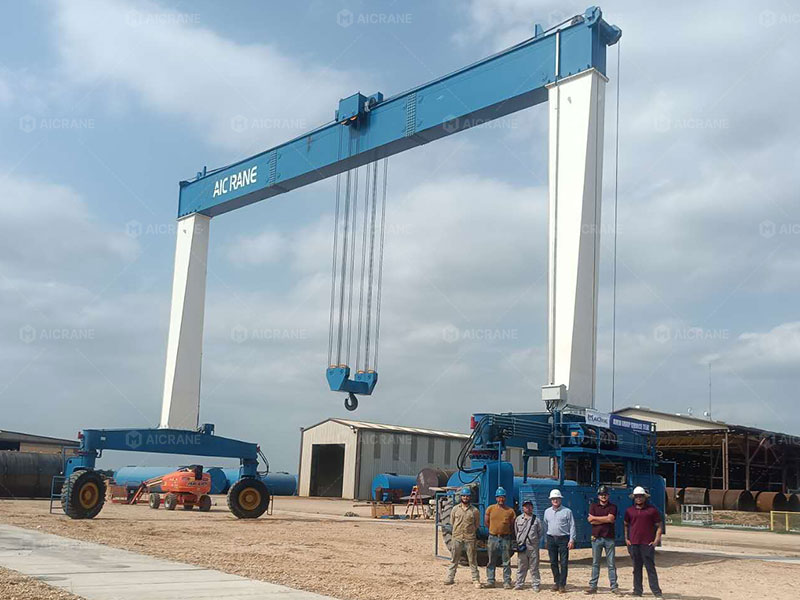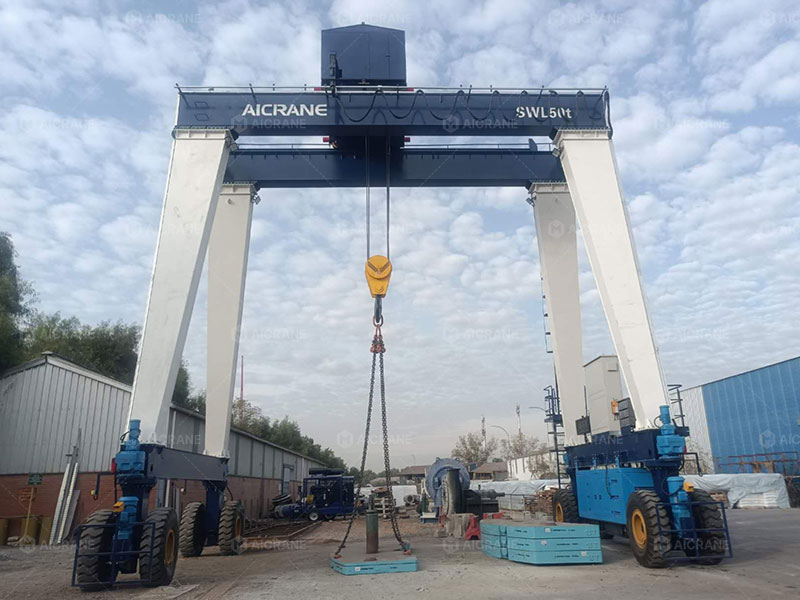Rubber Tyred Gantry (RTG) cranes play a crucial role in container terminals, intermodal yards, and large-scale industrial storage facilities, where mobility, precise container handling, and flexibility are vital. One of the most critical design aspects that affect the performance, efficiency, and operating cost of an RTG crane is its drive system. Two primary drive systems dominate the market: electric drive systems and hydraulic drive systems. Each comes with its own set of advantages, limitations, and ideal application scenarios.
In this article, we’ll explore the key differences between electric and hydraulic drive systems for rubber tyre gantry cranes, their working principles, and which option is better suited for specific operations.

Overview of RTG Cranes
Rubber Tyred Gantry cranes are mobile gantry cranes equipped with rubber wheels, allowing them to travel horizontally over storage yards. They are most commonly used for stacking and moving containers in vertical rows and are designed to move between rows without fixed rails.
The mobility of RTG cranes requires an efficient and powerful drive system to handle tasks such as:
-
Traveling the crane structure across the yard
-
Lifting and lowering heavy loads
-
Positioning the trolley across the gantry span
The choice of drive system directly affects:
-
Energy consumption
-
Maintenance requirements
-
Environmental impact
-
Control precision
-
Operational efficiency
Electric Drive Systems
How It Works
Electric drive systems use electric motors to power all motion functions of the gantry mobile crane: travel, hoisting, and trolley movement. These motors are typically powered by:
-
A diesel generator (diesel-electric RTGs), or
-
An external power supply via cable reel or busbar (fully-electric RTGs)

Key Components
-
Electric motors (AC or DC)
-
Variable Frequency Drives (VFDs)
-
Control units and sensors
-
Cable management systems
-
Power source: diesel generator or shore power
Advantages of Electric Drives
1. Energy Efficiency
Electric motors are more energy-efficient compared to hydraulic systems, especially when integrated with VFDs. Energy losses due to heat and fluid dynamics are lower in electric systems.
2. Lower Emissions
Fully electric RTGs connected to a shore power supply produce zero local emissions, making them suitable for ports aiming to reduce carbon footprints and comply with green port initiatives.
3. Precise Control
Electric drives offer better motion control, smoother starts/stops, and reduced wear on mechanical components. This translates to greater accuracy in container handling and reduced risk of swaying.
4. Lower Maintenance
Electric systems require less frequent maintenance than hydraulic systems. There are no fluid leaks, pump failures, or contamination risks, and the motors have longer service lives.
5. Quiet Operation
Electric drive systems produce less noise, which is a significant advantage in urban port areas or near residential zones.
Disadvantages of Electric Drives
-
Higher initial cost: Full electrification, especially with shore power infrastructure, can be capital intensive.
-
Dependency on grid infrastructure: Fully electric systems require reliable external power sources and cable management systems.
-
Limited mobility for cable-fed systems: Cable-powered RTGs have a limited operating range and may be less flexible in layout compared to diesel-hydraulic cranes.
Hydraulic Drive Systems
How It Works
Hydraulic drive systems use a diesel engine to drive a hydraulic pump, which then powers hydraulic cylinders and motors for the crane’s movements. Fluid pressure is used to transfer energy to various actuators across the gantry crane.
Key Components
-
Diesel engine
-
Hydraulic pump
-
Hydraulic cylinders and motors
-
Hoses and valves
-
Hydraulic oil reservoir and filters
Advantages of Hydraulic Drives
1. High Power Density
Hydraulic systems are known for their high force output and compactness. They are particularly effective in cranes that require high lifting capacity in a compact design.
2. Proven Technology
Hydraulic drive systems have been used in cranes for decades. Operators and maintenance crews are often more familiar with their operation and troubleshooting.
3. Simple Mobile Setup
Diesel-hydraulic RTGs are self-contained and don’t require external infrastructure like power cables or busbars. This allows greater flexibility in movement and deployment across large yards.
4. Lower Upfront Investment
In many cases, diesel-hydraulic cranes have lower initial costs compared to fully electric systems, especially when electrification infrastructure is not yet available.
Disadvantages of Hydraulic Drives
1. Lower Energy Efficiency
Hydraulic systems suffer from significant energy losses due to friction, fluid compression, and heat dissipation. This results in higher fuel consumption and operating costs over time.
2. Higher Maintenance Needs
Hydraulic systems involve many moving parts and fluid lines that require regular inspection and maintenance. Common issues include leaks, contamination, and component wear.
3. Environmental Concerns
Hydraulic fluid leaks can pose environmental risks, especially in port areas close to water bodies. Additionally, diesel engines emit greenhouse gases and particulates.
4. Less Precise Control
Hydraulic systems are generally less precise than electric systems, especially in terms of load positioning and speed control. This can lead to increased cycle times and reduced handling accuracy.
Comparing Electric vs Hydraulic RTG Drive Systems
| Criteria | Electric Drive | Hydraulic Drive |
|---|---|---|
| Energy Efficiency | High | Moderate to Low |
| Control Precision | Excellent | Moderate |
| Environmental Impact | Low (zero emissions if shore powered) | High (emissions + oil leaks) |
| Maintenance Requirements | Low | High |
| Noise Levels | Low | High |
| Mobility | Limited (cable-fed) or diesel-electric | High |
| Initial Investment | Higher (for full electrification) | Lower |
| Infrastructure Needed | Yes (for shore power systems) | No |
Which System is Best for You?
Choose Electric Drive If:
-
Your port or yard prioritizes sustainability and low emissions
-
You have access to stable grid power
-
You want precision handling, lower noise, and reduced maintenance
-
You plan for long-term operational cost savings
Choose Hydraulic Drive If:
-
You operate in a remote or developing area without shore power infrastructure
-
You need high lifting power in a compact and mobile design
-
Your yard layout requires maximum mobility without restrictions from cables
-
You have limited upfront budget and can manage higher maintenance
Future Trends in RTG Drive Technology
-
Hybrid Drive Systems: Combining diesel engines with energy recovery and electric assist to balance mobility and efficiency.
-
Battery-Electric RTGs: Rechargeable battery-powered cranes are gaining popularity for medium-range yard operations.
-
Digital Control Integration: Smarter drive systems with AI-based load tracking and path optimization.
-
Green Port Initiatives: Governments and port authorities are incentivizing electric RTGs to meet emissions regulations.
Conclusion
The drive system is a core component that defines the performance, cost-effectiveness, and environmental impact of an Aicrane RTG crane. While electric systems offer better energy efficiency and lower emissions, hydraulic systems still provide flexibility and familiarity in many applications. The best solution depends on your facility’s infrastructure, operational priorities, and long-term strategy.
A well-informed decision today will help you optimize performance and reduce costs for years to come.